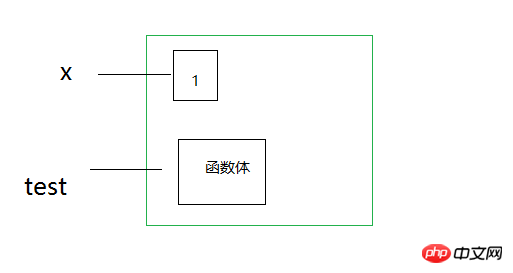
装饰器
一、定义
1.装饰器:本质是函数
2.功能:用来装饰其他函数,为其他函数添加附加功能
二、原则
1.不能修改被装饰函数的源代码
2.不能修改被装饰函数的调用方式
三、实现装饰器
1.函数 即变量的概念
2.高阶函数
3.嵌套函数
>> 高阶函数 + 嵌套函数 = 装饰器
四、函数 即 变量
1、函数和变量的类比
x = 1 print(id(x)) def test(): pass print(test) #输出 1842348496
在上例中我们定义了一个变量 "x" 和一个函数 test(),我们分别打印出变量和函数在内存中的位置。可以看出,print(test) 即 print("函数名")的时候,我们可以打印出函数的内存地址。
我们看下面的代码:
def test(): print("in the test.") f=test f() #输出 in the test.
我们把函数名 test 赋予给 f,然后运行 f(),可以看出函数是可以正常运行的,而且就是test函数的运行结果。那么这和下面的代码是不是类似:
x = 1 y = x print(y) #输出 1
我们可以做出如下类比,函数名 test 相当于 x ,函数体就相当于 1,而 f 就相当于 y。
2.python中内存的表现形式

我们把绿方块当作是内存,每一个小方块就是变量或者函数在内存当中的地址。而变量名(x)或者函数名(test),我们可以形象的将他们比作门牌号。当需要调用变量或者函数的时候,我们只要引用他们的门牌号就可以找到他们的内存地址并返回。只是函数的运行需要加(),如 test()。
既然调用变量其实就是引用变量的内存地址,而调用函数名同样可以得到函数体的内存地址。我们就可以把函数名当作变量名传给函数,即函数就是变量。而将函数当作参数的函数,也就是高阶函数。
五、高阶函数
满足下列条件之一就是高阶函数
1.把一个函数名当作实参传给另外一个函数
2.返回值中包含函数名
1)函数名作为参数
import time def test1(): time.sleep(2) print("in the test1.") def test2(func): start_time = time.time() func() stop_time = time.time() print("The action time of program is {}".format(stop_time-start_time)) test2(test1) #输出 in the test1. The action time of program is 2.0012054443359375
以上事例中,我们定义了一个函数 test1,同时也定义了一个高阶函数test2。我们把test1函数名当作参数传入test2中,可以实现这样一个功能,为原本的test1函数添加了一个计算运行时间的功能。这有点像装饰器了,但是有一点符合,就是上面的高阶函数test2改变了函数的调用方式。
但是我们实现了在不修改被装饰函数的基础上,添加了新功能。
2)返回值中有函数名
def test1(): time.sleep(2) print("in the test1.") def test2(func): print(func) return func test1 = test2(test1) test1() #输出 in the test1.
在上例中,我们最后将高阶函数test2(test1) 赋予给了test1,再次调用test1函数。我们可以直观的看到test1函数的调用方式在此例中没有改变。但是也并没有添加新功能,而这就需要使用到嵌套函数了。
六、嵌套函数
在函数体内又另一个函数的完整定义,这就是嵌套函数。
1)定义:
def foo(): print("in the foo") def bar(): print("in the bar") bar() foo()
仅仅在函数内容调用函数,就不是嵌套函数,如下:
def test1(): print("in the test1.") def test2(): test1()
2)嵌套函数的作用域
局部作用域和全局作用域的访问顺序
x = 0 def grandpa(): x = 1 def dad(): x = 2 def son(): x = 3 print(x) son() dad() grandpa() #输出 3
3)使用嵌套函数为被修饰函数添加新功能
在高阶函数第二例中,我们实现了不改变原函数的调用方式。而需要添加新功能的话,就要求修饰内容存在在返回值中,即return func 中,我们可以定义一个嵌套函数来实现这个功能。
import time def timer(func): # timer(test1) func = test1 def deco(): start_time = time.time() func() # run test1() stop_time = time.time() print("the action time of the program is {}".format(stop_time-start_time)) return deco # 返回了deco的内存地址 def test1(): time.sleep(2) print("in the test1.") test1 = timer(test1) test1() # 输出 in the test1. the action time of the program is 2.0003786087036133
我们在timer()内部定义了一个嵌套函数 deco(),这个嵌套函数实现了为被修饰函数添加运行时间的功能。而timer()函数返回了deco()的内存地址,这个内存地址deco就可以被引用,甚至直接赋予给 test1。这样我们就可以直接运行 test1(),这样就实现我们的装饰器的功能。
七、装饰器
python通过在函数定义前添加一个装饰器名和@符号,来实现对函数的包装
import time def timer(func): # timer(test1) func = test1 def deco(): start_time = time.time() func() # run test1() stop_time = time.time() print("the action time of the program is {}".format(stop_time-start_time)) return deco # 返回了deco的内存地址 @timer # test1 = timer(test1) def test1(): time.sleep(2) print("in the test1.") test1()
Atas ialah kandungan terperinci 装饰器decorator详解及实例. Untuk maklumat lanjut, sila ikut artikel berkaitan lain di laman web China PHP!
 Cara menyediakan Douyin untuk menghalang semua orang daripada melihat hasil kerja
Cara menyediakan Douyin untuk menghalang semua orang daripada melihat hasil kerja Apakah kegunaan dezender?
Apakah kegunaan dezender? Konsep m2m dalam Internet Perkara
Konsep m2m dalam Internet Perkara Apakah suhu biasa komputer riba?
Apakah suhu biasa komputer riba? Apa yang perlu dilakukan jika halaman web tidak boleh diakses
Apa yang perlu dilakukan jika halaman web tidak boleh diakses Apakah maksud STO dalam blockchain?
Apakah maksud STO dalam blockchain? Apakah kaedah untuk melaksanakan lebihan beban operator dalam bahasa Go?
Apakah kaedah untuk melaksanakan lebihan beban operator dalam bahasa Go? Bagaimana untuk menyemak sama ada port 445 ditutup
Bagaimana untuk menyemak sama ada port 445 ditutup



